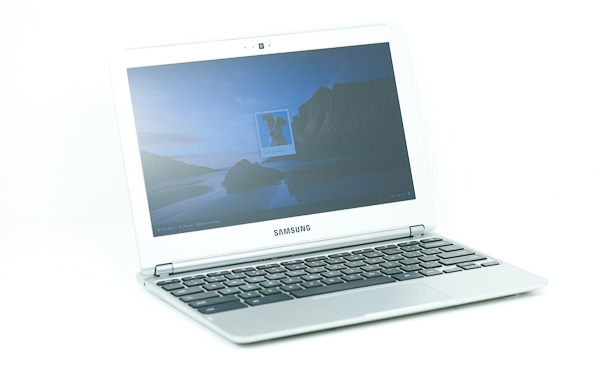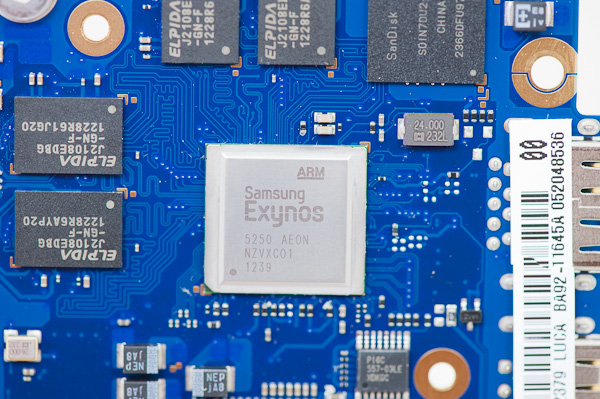Samsung Chromebook (XE303) Review: Testing ARM's Cortex A15
by Anand Lal Shimpi on October 31, 2012 9:00 AM ESTGoogle announced the Chrome OS project two years ago, and with it came the first Chromebook: the CR-48. The Chrome OS concept seemed revolutionary at the time. In 2010 we were well into the latest round of questioning whether today's PCs were fast enough. The Ultrabook revolution hadn't yet begun, and the iPad was starting to gain momentum. Capitalizing on the market being flooded with poor quality, yet affordable PC notebooks that still struggled with the same virus/malware issues they'd been facing for years, Google took the opportunity to attempt to revolutionize the PC OS.
Chrome OS was that attempt at a revolution. As an OS built around a web browser, Chrome OS offered many of the advantages that the Chrome browser itself brought to the table: sandboxing, guest mode and constant/painless updates. All user data is encrypted on the drive by default. Security was and remains a major feature of Chrome OS.
Google's revolution extended to hardware as well. The Cr-48 notebook delivered a good keyboard, trackpad and solid state storage. Future Chromebooks would do the same. While the price points of these machines (<$500) kept ultra high resolution IPS displays out of the bill of materials, Google promised good build quality and solid state storage - two things you couldn't find in cheap notebooks of the time.
Since then, some of the traditional PC makers have woken up. Although confined to the $999+ price point, we're finally seeing attention paid to build quality, display quality and storage performance. Over the next couple of years there's going to be increased focus on bringing those premium features down to sub $700 price points.
For Chrome OS and Google's Chromebooks to remain relevant, they also had to move down the pricing stack. With its most recent announcement, Google has done just that. The new Chromebook (Samsung XE303C12) is priced at $249, while maintaining much of what made its predecessors interesting.
Even more interesting than its aggressive price point is the choice of SoC inside Google's new Chromebook: Samsung's Exynos 5 Dual, featuring two ARM Cortex A15 CPU cores. This move makes the new Chromebook the very first non-x86 machine to ship with Chrome OS. Given that I also happen to have a dual-core Atom based Chromebook from 2011, the new Exynos 5 based machine gave me a unique opportunity to get a preview of how ARM's next-generation CPU core would stack up against Atom.













149 Comments
View All Comments
extide - Wednesday, October 31, 2012 - link
Yeah, basically this next gen 22nm Atom core is going to be make it of break it for the Atom. I can see the Atom getting canned entirely if the 2nd gen core on 22nm sucks.andrewaggb - Wednesday, October 31, 2012 - link
Yeah, intel must be feeling crazy pressure. They are 6-12 months behind. Both Haswell and the new atom should be coming out now with windows 8.amdwilliam1985 - Wednesday, October 31, 2012 - link
I'm impressed by the ARM performance, besides the performance and battery life, there is also the cost to consider. As far as I know, ARM cpu cost much less than x86 cpu.If I can get 50% of power for 25% of the price, that sounds like a good trade off in many scenarios.
wsw1982 - Thursday, November 1, 2012 - link
The samsung arm a15 is basically a 6+ w SOC... If you linear scale the medfield up 3 times, it means a three core atom, and three times the graphic power (does scale linearly), and i think the performance is comparable. The medfeld is arround 64 mm2, and the three core atom and graphic is, to my best guess, 100mm2, any one give me a estimation of the die size of the samsung a15? we can calculate the price :)krumme - Friday, November 2, 2012 - link
The intereting thing is the total cost for the OEM. The A15 implemented as here must be dirt cheap.Intel have high fixed cost, but arm can spread the cost to phones whatever through both Samsung but primarily TSMC.
In the long run it will be difficult for Intel the have the same low cost.
Years back they could use old fab equipment for the Atom and in that way use production capacity that had been written off the the worst part. Today they they need the new process nodes to be competitive, and that will raise cost for the Atom. I think they are in a bad market here.
Competing with TSMC and Samung is another world from competing with AMD and GF.
They need their ultrabooks, but the market is to small for the future fab cost.
Now arm can share cost from phones to notebooks. That is massive cost advantage imho.
mayankleoboy1 - Wednesday, October 31, 2012 - link
A chromebook is too niche a product to properly judge a SoC . Typically thermals are completely different.Its fast, yes, but how will it do in a smartphone ? And chromeOS has too few apps and the chromebook has too less a res to actually judge the best SoC .....
Krysto - Thursday, November 1, 2012 - link
Not like the Atom one was using bigger resolution. And Exynos 5 Dual can support up to 2560x1600, as we've already seen with Nexus 10.MilwaukeeMike - Wednesday, October 31, 2012 - link
Maybe I missed it, but does this have a built in webcam? Looks like it does from info on other sites, and I'd like to know how it performs for Skype purposes if anyone knows. Sounds like videos from youtube/facebook work ok as well, which would make this a great netbook style option.deneb - Wednesday, October 31, 2012 - link
For that price, why wouldn't anyone get a used laptop instead? At least then they'll get the benefit of a proper OS of their choice (linux or Windows, i don't know if used apple lappies go that low).Granted, it wouldn't be new, but at least it would be many times more functional - no? :)
Midwayman - Wednesday, October 31, 2012 - link
Battery life. A old low end laptop is going to have terrible battery life.